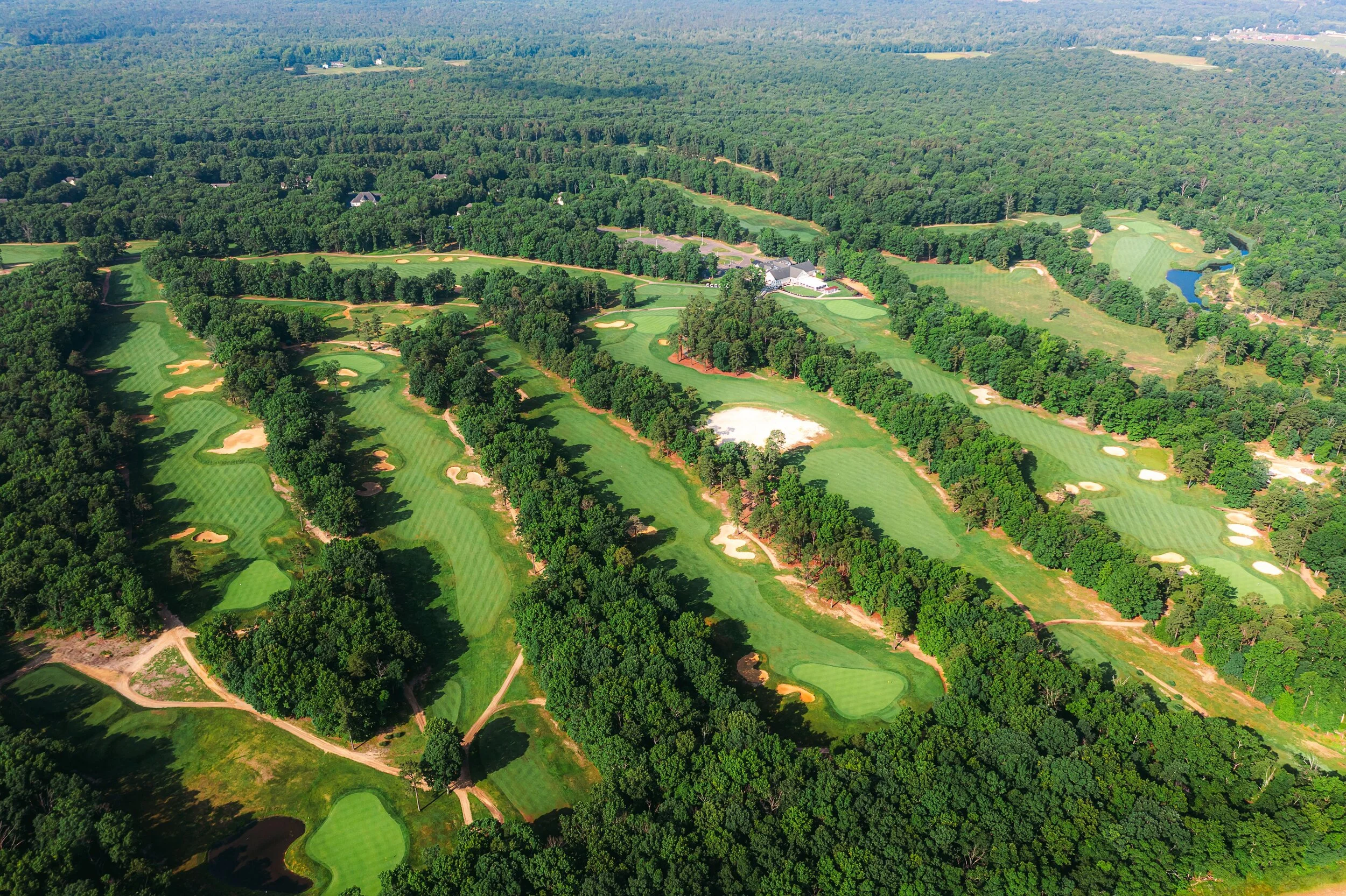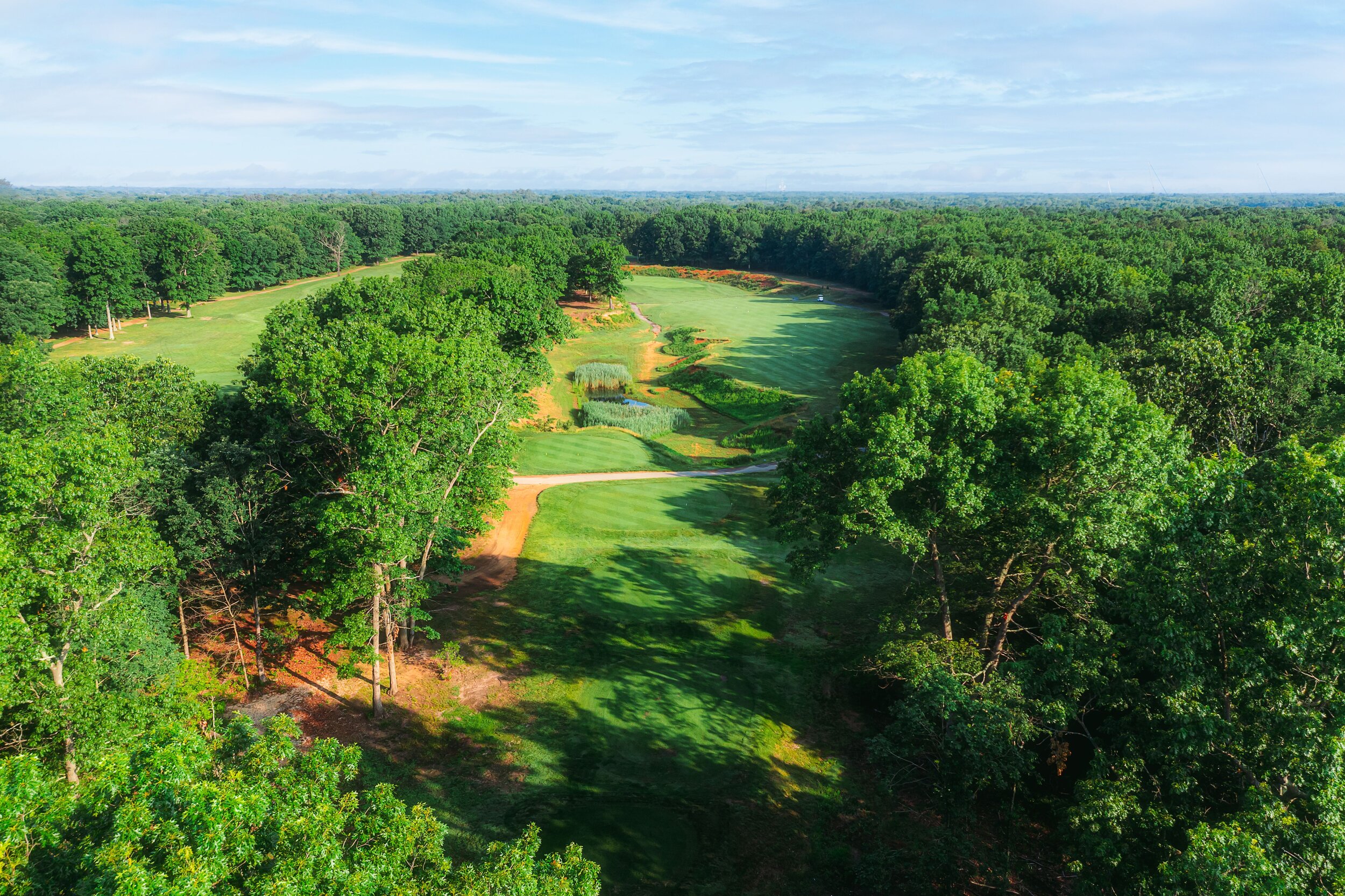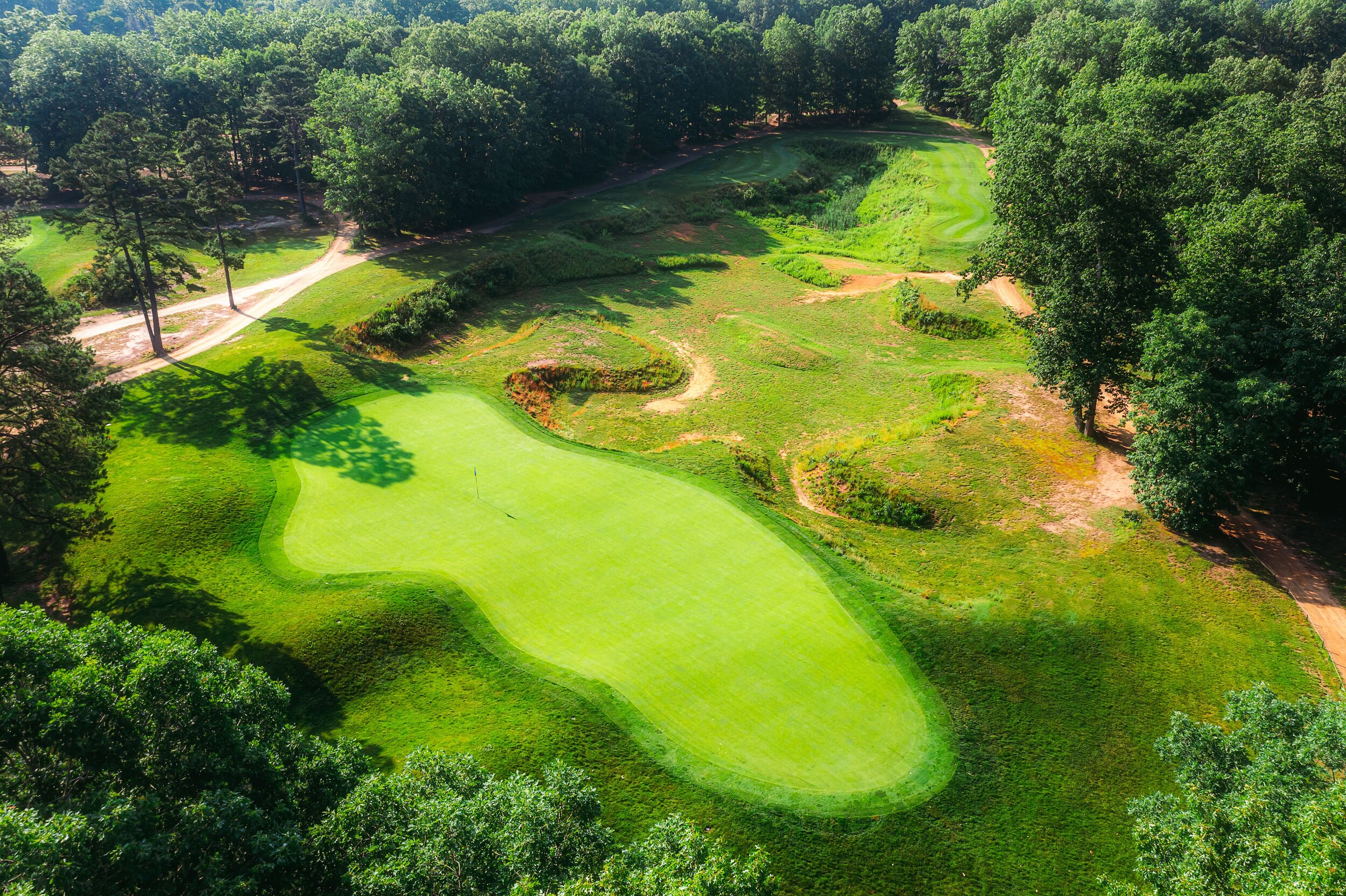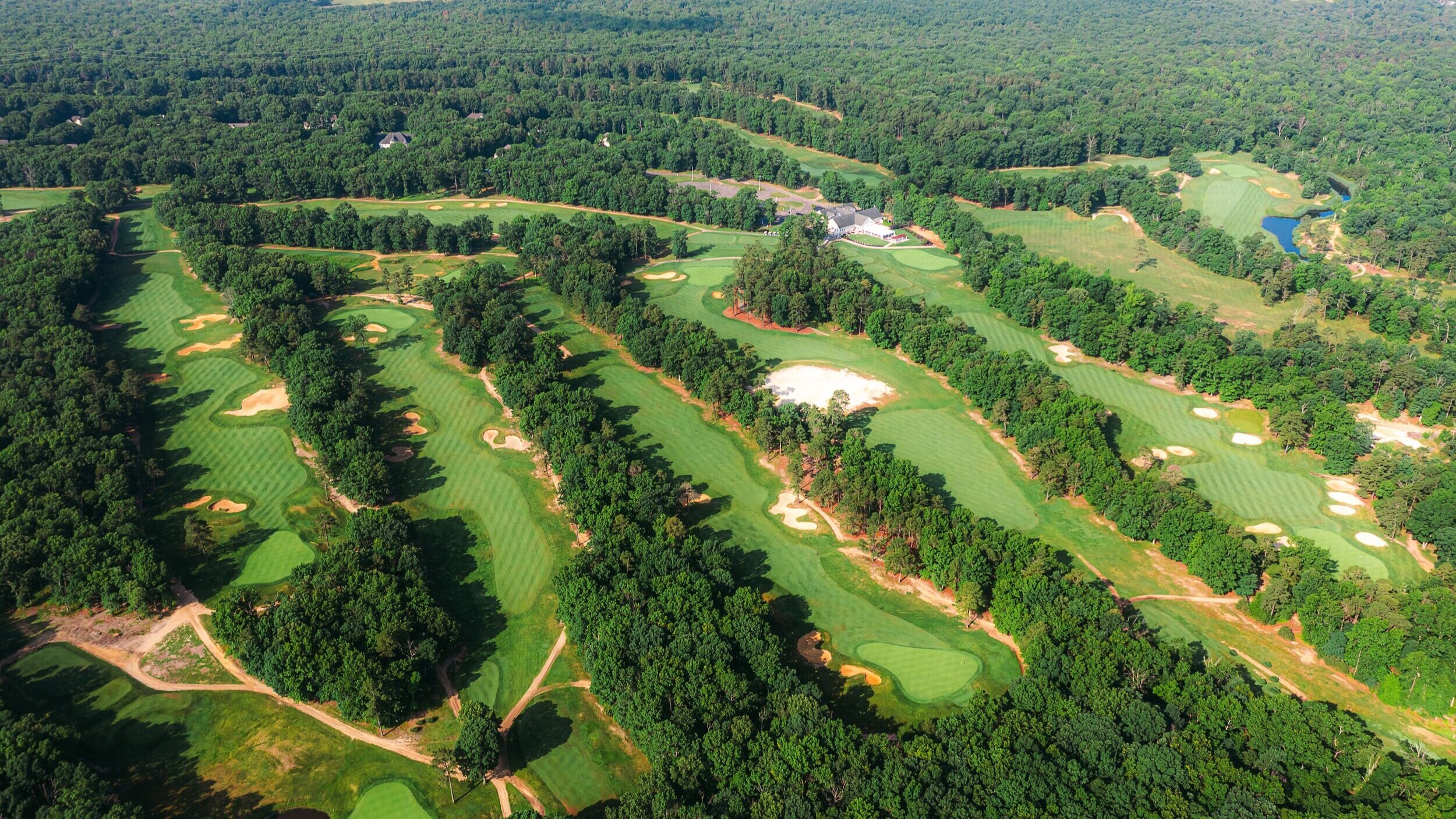RUNNING DEER GOLF CLUB
Course Architect: Edward Carman (2000)
Year Opened: 2000
Location: Pittsgrove, New Jersey
Slope: 130. Rating: 73.9
Par: 72
Yardage: 7,132
Hole-by-Hole: 1 - Par 4 394 Yds 10 - Par 4 408 Yds
2 - Par 4 492 Yds 11 - Par 4 357 Yds
3 - Par 4 381 Yds 12 - Par 4 478 Yds
4 - Par 5 521 Yds 13 - Par 3 243 Yds
5 - Par 3 180 Yds 14 - Par 5 555 Yds
6 - Par 4 417 Yds 15 - Par 4 358 Yds
7 - Par 3 184 Yds 16 - Par 3 185 Yds
8 - Par 4 409 Yds 17 - Par 5 553 Yds
9 - Par 5 538 Yds 18 - Par 4 479 Yds
Par 36 3,516 Yds Par 36 3,616 Yds
Key Events Held: NFL Philadelphia Eagles Alumni Tournament Qualifier (2009-present), Christman Cup (2016), U.S. Open Local Qualifier (2017), Philadelphia Junior Amateur, Philadelphia Amateur Qualifier (2021), U.S. Open Local Qualifier (2024).
Awards Won: Ranked number 20 in New Jersey - Golf Digest (2005-06).
Website: www.runningdeergolfclub.com
HISTORY: For original owner Edward Carman and his family, Running Deer Golf Club was a labor of love. You see, Carman designed the layout, and his sons - J.R. and Ted - were head professional and course superintendent, respectively.
Carman, a member of the PGA in the early 1950s, was the first head professional at Buena Vista Country Club (NJ), but always dreamt of his own golf course. With help from his family, those dreams turned into a reality.
Certainly not as well known as the likes of Donald Ross, Alastair Mackenzie, Robert Trent Jones or Pete Dye, Carman designed only two courses in his life, Centerton Golf Club and Running Deer.
As the years went by, Carman's design, spread out over 300 acres, had begun to receive high marks, including being rated 20th in the state of New Jersey by Golf Digest. However, the next few years, the course suffered, and according to many reports, Carman overextended himself, thus allowing the golf course to fall into disarray, while losing many of its loyal members.
Fast-forward to 2008 and the sale of the club to former NFL quarterback, Ron Jaworski. The former Philadelphia Eagles starting signal caller and his partner Ken Kochenour purchased Running Deer in the fall of '08 and were able to persuade Charlie Clarke, the former superintendent at Woodbury Country Club, to join the fold. To say that Jaworski was ecstatic about the purchase would be an understatement. "We are extremely excited to take over a facility with this much class."
“My dad had played the course several times before the sale, and he just really loved the layout and thought it was just a special place,” commented B.J. Jaworski, President of Jaworski Golf.
The United States Golf Association was certainly impressed, as they held a 2017 U.S. Open Local Qualifier at the course. “We’re confident that the competitors will have a great experience here and will enjoy the challenge presented by Running Deer in their quest to qualify for the U.S. Open,” said Klay Knerr, Director of Golf at Running Deer.
How tough was the course you ask? Not one player broke par. That’s right, the low score was an even-par 72 by two players, one of which was an amateur, Lodie Van Tonder, a former member at Running Deer. “I love [Running Deer], I still call it my second home. Coming from South Africa, I love playing in these winds,” said Van Tonder, who relocated to the United States over a dozen years ago. “It’s a tough course under normal conditions,” commented B.J. Jaworski. “Add in strong winds and slick putting surfaces and you get those scores.”
Just recently, Running Deer hosted another important regional event, a qualifier for the BMW Philadelphia Amateur Championship. The results were not better, as Evan Barbin carded the lowest round, a one-over 73. In fact, Barbin needed two birdies on his final four holes to secure the top spot.
The USGA returned to Running Deer in 2024 for a U.S. Open Local Qualifier. The course played at 6,986 yards and only two players broke 70, Stephen Cerbara and Matthew Ryan with 3-under-par 69s to earn co-medalist honors. In all, only five players broke par out of the 60 player field.
Seems to me that Jaworski and company have taken Running Deer to the next level and beyond!
HOLE-BY-HOLE REVIEW: The opening hole at Running Deer is a modest par four of 394 yards. The tree-lined fairway is made even tighter by a 70-yard bunker down the left side. Three-metal is a good play off the tee, setting up a short iron to a very difficult putting surface. The green boasts several humps and bumps, making it difficult to get it close. Birdie is a possibility, but par is likely.
Number two is a bear of a par four, that’s right, par four stretching 492 yards from the tips. The
split fairway is quite deceiving with the 150-yard stake residing in the rough. In fact, you'll be left with a very long uphill approach regardless of how far you blast your drive, as your tee ball will feed towards the center of the fairway thanks to the large banking on both sides of the landing area. Trees on both sides certainly narrow the fairway, but it's the length that will get you. Another sloping green from back to front, so stay below the hole for your best shot at saving par.
The third is a beautiful, short, dogleg left par four that's target golf at its best. Just 381 yards, you'll need a fairway metal or long iron off the tee to hit a landing area, which is flanked on the right by trees and the left by a sandy, clay pit which wraps around most of the hole. If you’re bold, take driver and hit a high draw to leave a short pitch. Your second shot will be played down towards the island, raised green which is surrounded by clay and the natural sand. The immense putting surface is three-tiered and slick, so be careful or a three-putt could be in the offing.
It's risk-reward time when you reach the fourth. A relatively short par five at 521 yards by today's standards, this one requires splicing the numerous fairway bunkers that dot the landing area. If accomplished, then you can have a go, otherwise, play it as a three-shotter and give yourself a shot at birdie like they did years ago, by sinking a 10-footer for birdie. That's what I tried to do, but I still missed the putt.
The first par three on the course is the shortest of the quartet at just 180 yards. Trouble on the right in the form of a pond, will keep you honest, but with a short iron in hand, you should be able to navigate the approach. The putting surface has plenty of character, and stretches over 40 paces from back to front, so depending on the pin placement, don't get greedy.
Another tree-lined par four, the sixth is straightaway with plenty of sand on both sides of the fairway to catch your errant tee ball. Rated as the fourth hardest hole on the front side, you’ll have more sand to negotiate with your approach, so play right of the green if you must and rely on your short game.
One of the several signature holes at Running Deer, the seventh is a great par three that runs up to 184 yards from the back markers. The trouble is club selection, as the entire hole is played over a clay and natural sand quarry. The putting surface is 50 yards wide and shallow, making your target even more difficult. A back-left flag could add 20 yards to the hole, forcing a draw around a group of trees. Who said par threes had to be easy?
No surprises on the eighth, it's just a straightaway par four of 409 yards, with trees running down both sides of the fairway and a pair of bunkers on either side of the landing area. A short to medium iron will remain to a well-bunkered and undulating green. This hole can be had, but you'll have to be spot on.
The closing hole on the outward nine is the shortest and trickiest par five on the course. The key is the tee ball, which must favor the right side or play short of the "Pine Valley" like waste area down the center of the fairway. A successful tee shot will leave a 200-220 yard shot to the green. This is where the fun begins, as the putting surface is tucked to the right behind a section of tall trees. The front of the green is protected by several bunkers, so if you can manage a high-cut with a hybrid or a fairway metal, then go for it. Otherwise, play down the fairway and leave yourself a short pitch to another undulating green. If you haven't found out yet, birdies are hard to come by at Running Deer. “The most important thing on the ninth, is playing the proper tees,” said B.J. Jaworski. “If you play the correct tee, you should be left with approximately 240 yards to the green. If you want to try and hit a high-cut over the trees, and play that risk-reward shot and be on in two, then it’s a good shot and you can take that risk on. The challenge comes from when the player plays from the wrong tees and they drive into the waste area and frustration sets in, wondering, how can I get home in two.”
The back nine starts with a rock-solid par four that requires thought off the tee. Several traps guard both sides of the landing area, especially where the fairway tightens as you get closer to the hole. The best play would be a three-metal off the tee, as this sets up a medium to short iron to a long
putting surface with sand on both sides. The two-tiered green, which is 46 yards in depth, slopes hard from back to front, so once again, below the hole is the best position. “We had a gentleman named Dave Otis come out after we purchased the club in 2009 and he mentioned that we had these really cool bunkers on the right, but there were a bunch of trees right in between the bunkers, which made it like a double-penalty. So we did some tree removal there to eliminate the double-penalty.”
If you thought the first 10 holes were something, just wait to you reach the 11th tee. One of the shortest par fours on the course, this sharp dogleg left must be played carefully. Trees hug the entire right side of the fairway, while three bunkers guard the right-corner of the landing area. Water creeps out on the left side, just past another fairway bunker and then runs down the remaining left side through the green. Bunkers guard the rear and right of the two-tiered putting surface, which slopes from back to front. A short pin can be attacked, but be leery of the pond.
There is no question that the 12th is the hardest hole on the course. At 478 yards, the length is not impossible, but its shape might be. A hard dogleg right around two sections of water, makes you think twice on the tee. First of all, your tee shot must be shaped from left to right to cut the corner and be high enough to clear the stand of trees down the right. The left side of the landing area is wall-to-wall trees, so no bailout possible. Then you're left with an uphill approach to a well-guarded, sloping green that reaches 45 yards in depth. With a back pin, your approach is almost a blind one, as you can only see the top of the flag. The one question mark of the hole is the hard-canting fairway that slopes toward the water. Making bogey here is not the end of the world!
The 13th is a brilliant par three, not to mention the longest on the course at 243 yards. If the wind is up, you might need driver to get home and if the pin is back-left, good luck. I'm not so sure that this isn't the hardest hole at Running Deer. The bunker short and left gets plenty of action, but the green, with its back-to-front slope, is a killer. Not many people will make birdie here, let alone par. There is no doubt that your short game will be tested.
One of my favorites at Running Deer is another risk-reward signature hole, the par-five, dogleg left 14th. Out of a chute of trees, your tee shot plays slightly downhill towards the tight, tree-lined fairway. From there, a player has a couple of options, go for the green or lay up short and right. If you go for the green, make sure your tee shot is past the group of trees that stick out on the left side. The sensible play for us mortals is out to the right, leaving a short pitch to a very long putting surface. Not only is the green lengthy (47 yards in depth), but it features several swales, putting extreme pressure on your flat stick.
Fifteen can be sort of a breather, as it only runs 358 yards from the tips. Don't be fooled - this little gem has plenty of bite, especially if you miss the fairway. Hybrid or long iron off the tee will leave a wedge in hand, giving the player an opportunity to attack the flag. The problem here is the
massive trap short of the green and the two-tiered, bowl-like putting surface. A front flag is simple, as all shots will funnel towards the pin, but a back-left or right flag can be hard to get at. Just 29 paces in depth, this green is the smallest on the course. Take your best shot, because birdies on the final three holes rarely happen.
The 16th is a modest par three, with a bunker on either side of the green. The putting surface is long and narrow and does slope from back to front, but it's not as severe as some of the others at Running Deer. Deep pins will be hard to attack, as the green narrows in the back. Take par and move on.
The final par five on the course, the 17th, can be fun if played right. The fairway is split in two and putting driver in your hand does run the risk of running down into the gully and water hazard that divides the landing area. Having said that, this is not a bad play, as it will leave a long iron or hybrid to an accessible green. Take aim at the tall tree in the fairway to leave your best angle of approach. Laying up is not a problem, as no fairway bunkers lie in wait, just a couple of pot bunkers at the green. Mounding right, short and rear can either help or hinder your approach, but this can be a birdie if you play your cards right.
The bottom line on the finale at Running Deer, it's just a hard hole. Doglegging to the right, the 18th is a hard driving hole with two bunkers pinching the fairway. If you can cut the corner of the dogleg, you'll give yourself the best chance of reaching the bunkerless green. If not, then you’ll be stuck in a deep fairway bunker. The putting surface, at 46 paces in length, is slightly raised and runs hard from back to front, so take an extra stick to get home in regulation, but stay below the hole. Put the pin in the back-right corner and you have one beastly closer.
"This is an exquisite layout for a golf course,” added B.J. Jaworski. “You can't duplicate what we have here; every hole is different and unique. We inherited such an amazing layout and we wanted to keep polishing and make the course better and better each year.”
FINAL WORD: I must admit that when I first played Running Deer many years ago, I swore that I would never play the course again. It wasn’t in very good shape, hospitality was lacking and the overall vibe was, well, very unappealing. Well, my wife always tells me, never say never, and that couldn't be more accurate in this case.
I just recently went back to Running Deer Golf Club and was more than pleasantly surprised.
The key to the transformation has to be Ron Jaworski and his team. The original owners had let the golf course go. Tees and fairways were almost indiscernible, the bunkers were rock-laden and the greens, well, let's just say they were rolling less than seven on the Stimpmeter.
“We continue to make improvements every year to the drainage and irrigation system,” added B.J. “It’s all about sunlight and air movement. If we can improve the morning sun and the air movement on a green or tee box, that’s something that moves to the top of our priority list.”
When Jaws and company purchased the layout, Charlie Clarke was the superintendent and he brought in a new attitude. Clarke now is the Vice President of Agronomy for the entire company and oversees all course conditions at all of Jaworski’s courses. Current superintendent Derek Carter has certainly followed Clarke’s lead and has helped improve the course dramatically.
Carved through the Pine Barrens of south Jersey, Running Deer was always a wonderful design, but the course is now well-defined, as several hundred trees were removed, irrigation was added and drainage updated.
With five sets of teeing grounds, ranging from just under 5,000 yards to 7,132 yards, this
South Jersey gem is for all skill levels. Just remember to pick the right markers.
Tree-lined fairways riddled with plenty of sand (approximately 70 bunkers), several water hazards and greens now reaching double-digits on the Stimp, makes Running Deer a must-play. RDGC was formerly a private club, but now with Jaworski at the helm, it is open to the public. “We’re proud that it’s a difficult golf course,” added B.J. “We just want to make sure that it’s fair.”
The reasonable rates make Running Deer all the more enticing. It isn't often that a championship layout costs less than $90. And if you’re a junior, how about $15 for a player under 17 after 3 PM and just $30 prior, during the week! Running Deer is a true, semi-private course that has public availability.
But that's not the half of it. Running Deer also features a wonderful practice facility with over 50 teeing areas. In addition, there is a full practice putting green and short-game area.
There's more to Running Deer than golf. The stately 17,000 square foot clubhouse features a spacious banquet facility, with elegant surroundings and a beautiful cathedral ceiling. And the food...outstanding. Whether for a wedding or corporate outing, Running Deer Golf Club can fill all of your needs. The wedding set up, overlooking the golf course from the back of the clubhouse is spectacular. “We are off the beaten path, but we feel that that’s part of the allure of the club,” added B.J. “We have one ballroom and we host amazing events in there, whether it be a wedding or any other special event. We really focus on individual events for the day. We are not some sort of factory. It feels exclusive, secluded and it’s an intimate experience that we can host for anybody.”
Jaws calls Running Deer his "Crown Jewel" of the Jaworski portfolio, which includes other New Jersey courses, Blue Heron Pines, Valleybrook, Ramblewood and RiverWinds, not to mention a pair of layouts in Pennsylvania. For now, the Jaworski golf holdings are complete with seven (Jaworski’s number with the Eagles), but one never knows!
One thing is for certain, since Jaworski started to take the snaps at Running Deer Golf Club, the course has moved to the forefront of championship golf in South Jersey.



